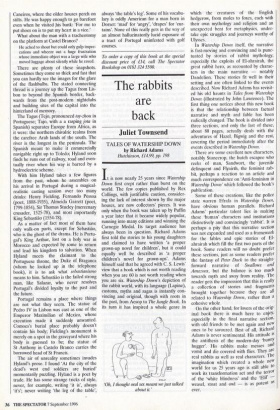The rabbits are back
Juliet Townsend
TALES OF WATERSHIP DOWN by Richard Adams Hutchinson, £14.99, pp. 198
It is now nearly 25 years since Watership Down first crept rather than burst on the world. The few copies published by Rex Collings, with justifiable caution, consider. ing the lack of interest shown by the major houses, are now collectors' pieces. It was only when the book was taken up by Puffin a year later that it became widely popular, running into many editions and winning the Carnegie Medal. Its target audience has always been in question. Richard Adams first told the stories to his young daughters and claimed to have written 'a proper grown-up novel for children', but it could equally well be described as 'a proper children's novel for grown-ups'. Adams himself said that he agreed with C. S. Lewis' view that a book which is not worth reading when you are 60 is not worth reading when you are six. Watership Down's depiction of the rabbit world, with its language (Lapine), customs, myths and sagas is instantly con- vincing and original, though with roots in the past, from Aesop to The Jungle Book. In its turn it has inspired a whole genre in
'Oh, I thought oral sex meant we just talked about it.' which the creatures of the English hedgerow, from moles to foxes, each with their own mythology and religion and an unexpected bent for metaphysics, under- take epic struggles and journeys worthy of Ulysses.
In Watership Down itself, the narrative is fast-moving and convincing and is punc- tuated by stories of rabbit mythology, especially the exploits of El-ahrairah, the great rabbit hero, as recounted by charac- ters in the main narrative — notably Dandelion. These stories fit well in their setting and are often linked to the events described. Now Richard Adams has revisit- ed his old haunts in Tales from Watership Down (illustrated by John Lawrence). The first thing one notices about this new book is that the relationship between factual narrative and myth and fable has been radically changed. The book is divided into three sections, and only the last of these, about 80 pages, actually deals with the adventures of Hazel, Bigwig and the rest, covering the period immediately after the events described in Watership Down.
There are some excellent new characters, notably Stonecrop, the hutch escapee who reeks of man, Sandwort, the juvenile delinquent and Flyairth, the feminist rab- bit, perhaps a reaction to an article and much correspondence on 'Anti-feminism in Watership Down' which followed the book's publication.
Some of these creations, like the police state warren Efrafa in Watership Down, have obvious human parallels. Richard Adams' particular talent lies in making these 'human' characters and institutions distinctively and convincingly 'rabbit'. It is perhaps a pity that this narrative section was not expanded and used as a framework for the fables and epic stories of El- ahrairah which fill the first two parts of the book. Some readers will no doubt prefer these sections, just as some readers prefer the fantasy of Peter Duck to the straight- forward narrative of Swallows and Amazons, but the balance is too much towards myth and away from reality. The reader gets the impression that this is really a collection of stories and fragments brought together because they are all related to Watership Down, rather than a cohesive whole.
On the other hand, for lovers of the orig- inal book there is much here to enjoy, especially in the final narrative section, with old friends to be met again and new ones to be savoured. Best of all, Richard Adams is never sentimental. His attitude Is the antithesis of the modern-day 'bunny hugger'. His rabbits make messes and vomit and die covered with flies. They are real rabbits as well as real characters. The imagination which created a whole new world for us 25 years ago is still able to work its transformation act and the terror of the 'white blindness' and the 'Elir -- weasel, stoat and owl — is as potent as ever.


























































 Previous page
Previous page